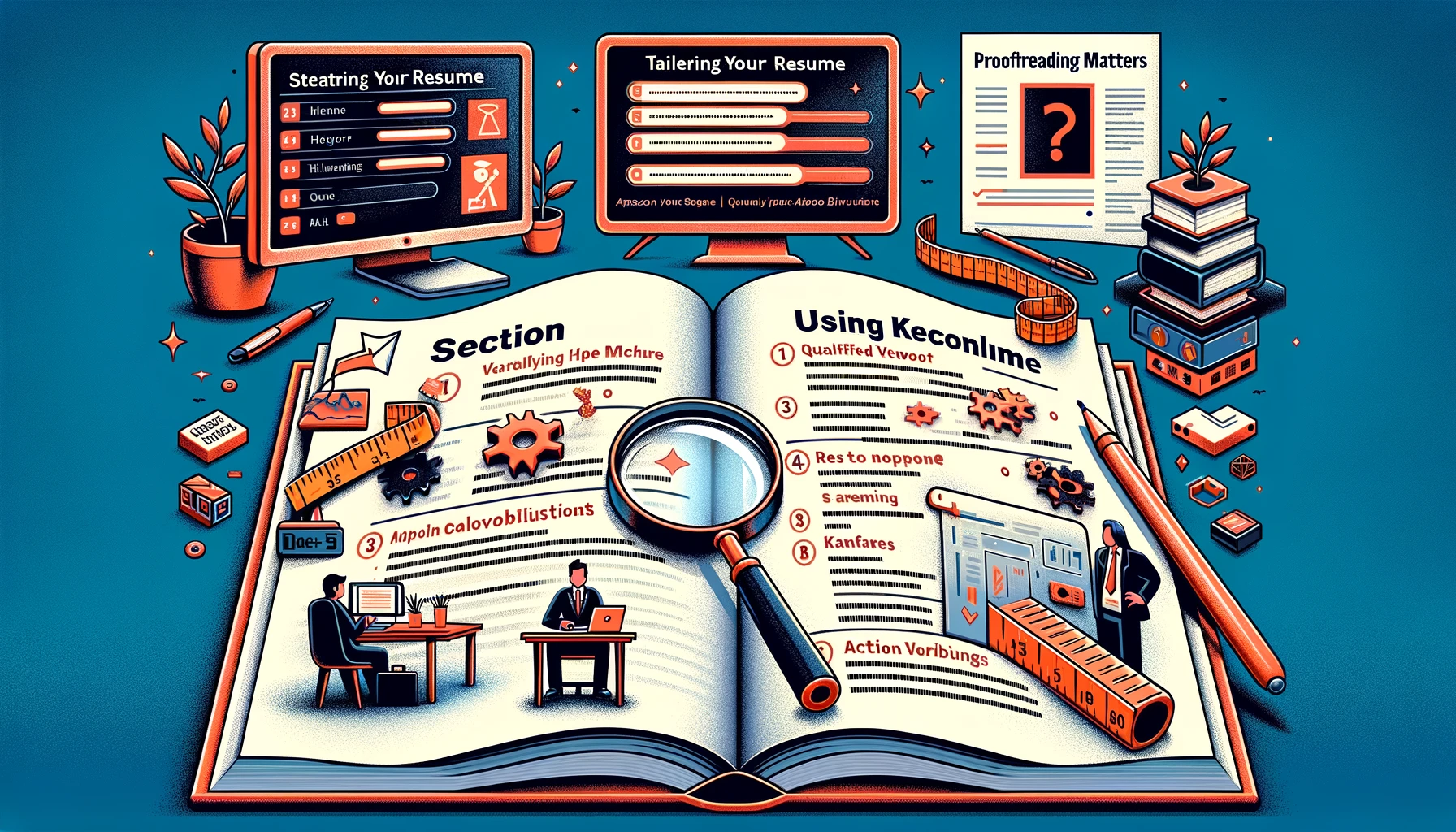Chapter-2: Crafting the Perfect Amazon Resume.
 In the world of Amazon job applications, your resume serves as your first point of contact with the company. To increase your chances of catching the eye of Amazon's recruitment team, it's essential to tailor your resume effectively.
In the world of Amazon job applications, your resume serves as your first point of contact with the company. To increase your chances of catching the eye of Amazon's recruitment team, it's essential to tailor your resume effectively.
In this chapter, we'll guide you through the art of creating a resume that not only impresses but also aligns with Amazon's expectations.
Section 1: Tailoring Your Resume.
When applying for a position at Amazon, one size does not fit all.
Tailor your resume to the specific job you are applying for by highlighting the skills and experiences most relevant to the role. Show Amazon that you've done your homework and that you are the perfect fit for their team.
Section 2: Using Keywords.
Amazon utilizes an Applicant Tracking System (ATS) to streamline the hiring process.
To ensure your resume gets noticed, incorporate keywords from the job description. These keywords act as beacons, guiding your resume to the top of the pile.
Section 3: Quantifying Accomplishments.
Numbers speak louder than words. Quantify your accomplishments wherever possible. This approach allows Amazon to gauge the real impact of your work.
 Whether it's revenue growth, cost savings, or project completion times, make sure your achievements shine through.
Whether it's revenue growth, cost savings, or project completion times, make sure your achievements shine through.
Section 4: The Power of Action Verbs.
Don't be passive; be proactive. Use strong action verbs and provide specific examples of your contributions. Show Amazon how you've made a difference in your previous roles.
Your resume should be engaging and informative, leaving no room for doubt about your capabilities.
Section 5: Proofreading Matters.
Errors can be costly. Before submitting your resume to Amazon, proofread it carefully. Ensure impeccable grammar and spelling. A single typo can tarnish an otherwise stellar application.
Section 6: The Anatomy of Your Resume.
Now, let's break down the components of your resume:
Summary: Your opening statement is crucial. Summarize your skills and experience concisely. Make it impactful; it's your first impression.
Skills: List your technical and soft skills. Focus on those most relevant to the job you seek.
Experience: Detail your work history, starting with your most recent position. Include company names, job titles, and dates of employment. Provide a comprehensive view of your responsibilities and accomplishments.
Education: Share your educational background, beginning with your most recent degree.
Include school names, degrees earned, and dates attended.
Additional Information: Use this section to showcase any other relevant information, such as awards, publications, or volunteer experiences.
Section 7: Presentation Matters.
Simplicity is key. Choose a clean and legible format. Avoid excessive formatting or extravagant fonts.
Utilizing a professional resume template can help streamline the process.
Section 8: Seek Feedback.
Don't go it alone. Seek feedback from trusted friends, family, or colleagues. Multiple perspectives can help you fine-tune your resume.
In the competitive world of Amazon interviews, your resume is your passport to opportunity.
Make it compelling, concise, and tailored to the role you desire. With the right approach, you can increase your chances of landing that coveted interview.
Before hitting the "Submit" button, remember to proofread your resume meticulously. At Amazon, every detail matters, and your resume is no exception.
In the next chapter, we'll delve deeper into the interview process, equipping you with the knowledge needed to shine during your Amazon interview.
Job Title and Resume:
Now let’s explore the art of crafting a compelling resume tailored to various job titles at Amazon.
Each role has its own unique requirements and expectations, and we'll provide you with detailed guidance to help you stand out in your application.
Section 1: General Tips for Resume Preparation.
Before diving into the specifics of each job title, let's establish some fundamental principles that apply across the board:
- Tailor Your Resume: Customize your resume for the specific job you're applying for. Highlight the skills and experiences most relevant to the position.
- Use Keywords: Incorporate keywords from the job description into your resume. This optimization will help your resume get noticed by Amazon's applicant tracking system (ATS).
- Quantify Accomplishments: Wherever possible, quantify your accomplishments to demonstrate the impact of your work. Numbers provide context and credibility.
- Strong Action Verbs: Use strong action verbs to convey your achievements effectively. Pair these verbs with specific examples to make your resume engaging and informative.
- Proofread: Meticulously proofread your resume to eliminate grammar or spelling errors. Attention to detail is crucial.
Section 2: Specific Tips for Each Amazon Job Title.
Now, let's delve into the specific resume preparation tips for each of the following Amazon job titles:
Software Development Engineer (SDE):
- Emphasize your programming skills and experience with data structures and algorithms.
- Highlight any relevant experience with software design principles and system design.
- Mention any familiarity with cloud computing platforms, especially AWS.
Web Developer:
- Showcase your proficiency in both front-end and back-end web development.
- List any relevant experience with popular web development frameworks like Django or Rails.
- Mention your expertise with essential web development tools, such as Git and Docker.

Amazon Web Services (AWS):
- Highlight your hands-on experience with AWS services like EC2, S3, and RDS.
- Include any relevant AWS certifications you've earned.
- If applicable, mention experience with other cloud computing platforms outside of AWS.
Software Development Engineer In Test I (SDET I):
- Draw attention to your experience with software testing methodologies and testing tools.
- Highlight any relevant background in automation testing.
- Mention any expertise in performance testing and security testing.
Data and Engineering Roles:
Now, we will delve into the art of creating a compelling resume tailored to data and engineering positions at Amazon. Each role has its unique requirements, and we'll provide you with specific guidance to ensure your resume shines in the application process.
Data Scientist:
- Highlight your skills in statistics, machine learning, and data mining.
- List any relevant experience with programming languages such as Python, R, and SQL.
- Mention any experience with big data processing tools and frameworks like Hadoop and Spark.
- Showcase projects that demonstrate your data science skills.
Machine Learning Engineer:
- Emphasize your skills in machine learning, software engineering, and cloud computing.
- List any relevant experience with machine learning frameworks such as TensorFlow and PyTorch.
- Mention any experience with cloud computing platforms such as AWS and Azure.
- Include projects that illustrate your machine learning engineering capabilities.
Data Analyst:
- Highlight your skills in data analysis, data visualization, and proficiency in SQL.
- List any relevant experience with business intelligence tools like Tableau and Power BI.
- Mention any experience with big data processing tools and frameworks like Hadoop and Spark.
- Include projects that demonstrate your data analysis skills.
Data Engineer I:
- Highlight your skills in data modeling, data warehousing, and data pipelines.
- List any relevant experience with programming languages such as Python, SQL, and Scala.
- Mention any experience with big data processing tools and frameworks like Hadoop and Spark.
- Showcase projects that demonstrate your data engineering capabilities.
DevOps Engineer:
- Emphasize your skills in automation, infrastructure management, and continuous integration/continuous delivery (CI/CD).
- List any relevant experience with DevOps tools and technologies like Ansible, Terraform, and Kubernetes.
- Mention any experience with cloud computing platforms such as AWS and Azure.
- Include projects that illustrate your DevOps engineering skills.
AWS Solution Architect:
- Highlight your skills in designing, deploying, and managing AWS solutions.
- List any relevant experience with AWS services, such as EC2, S3, and RDS.
- Mention any experience with AWS certifications, such as the AWS Certified Solutions Architect - Associate certification.
- Include projects that you have worked on that demonstrate your AWS solution architecture skills.
AWS Security Specialist:
- Highlight your skills in AWS security, compliance, and best practices.
- List any relevant experience with AWS security services, such as Amazon GuardDuty and AWS Identity and Access Management (IAM).
- Mention any experience with AWS security certifications, such as the AWS Certified Security - Specialty certification.
- Include projects that you have worked on that demonstrate your AWS security specialist skills.
AWS Networking Specialist:
- Highlight your skills in AWS networking services, such as VPC, Route 53, and VPN.
- List any relevant experience with network design, implementation, and troubleshooting.
- Mention any experience with cloud networking platforms other than AWS.
- Include projects that you have worked on to demonstrate your AWS networking skills.
AWS SysOps Administrator:
- Highlight your skills in AWS system administration, including managing EC2 instances, RDS databases, and EBS volumes.
- List any relevant experience with system monitoring, performance tuning, and troubleshooting.
- Mention any experience with cloud computing platforms other than AWS.
- Include projects that demonstrate your AWS sysops administrator skills.
AWS DevOps Engineer:
- Highlight your skills in AWS DevOps tools and technologies, such as Ansible, Terraform, and Jenkins.
- List any relevant experience with continuous integration/continuous delivery (CI/CD) pipelines.
- Mention any experience with cloud computing platforms other than AWS.
- Include projects that illustrate your AWS DevOps engineer skills.
Section 3: Additional Tips for All Titles:
Regardless of the role you're pursuing at Amazon, consider these additional tips:
- GitHub Profile: Include a link to your GitHub profile in your resume.
This allows Amazon recruiters to review your code and contributions to open-source projects.
- Cover Letters: Craft a well-written cover letter for each job application. This is your opportunity to introduce yourself to Amazon and explain why you're keenly interested in the role.
- Practice Interview Questions: Prepare for interviews by practicing common interview questions. Numerous online and printed resources provide lists of questions specific to your job title.
- Tailor Your Resume: Customize your resume for the specific job you're applying for.
Focus on highlighting the skills and experiences most relevant to the position.
- Use Keywords: Incorporate keywords from the job description into your resume. This optimization is essential for catching the attention of Amazon's applicant tracking system (ATS).

- Quantify Accomplishments: Whenever possible, quantify your accomplishments to showcase the impact of your work. Numbers provide context and credibility.
- Strong Action Verbs: Utilize strong action verbs to convey your achievements effectively. Pair these verbs with specific examples to make your resume engaging and informative.
- Proofread: Thoroughly proofread your resume to eliminate any grammar or spelling errors. Attention to detail is crucial.
- Interview Preparation: Practice answering common interview questions specific to data roles. There are numerous interview questions with answers will be provided in this book.
- With these tailored tips and the commitment to presenting your skills effectively, your resume will serve as a powerful tool in your Amazon job application. In the next chapter, we'll explore strategies to excel during Amazon's interview process, helping you secure your desired role with the company.

In this chapter, we'll guide you through the art of creating a resume that not only impresses but also aligns with Amazon's expectations.
Section 1: Tailoring Your Resume.
When applying for a position at Amazon, one size does not fit all.
Tailor your resume to the specific job you are applying for by highlighting the skills and experiences most relevant to the role. Show Amazon that you've done your homework and that you are the perfect fit for their team.
Section 2: Using Keywords.
Amazon utilizes an Applicant Tracking System (ATS) to streamline the hiring process.
To ensure your resume gets noticed, incorporate keywords from the job description. These keywords act as beacons, guiding your resume to the top of the pile.
Section 3: Quantifying Accomplishments.
Numbers speak louder than words. Quantify your accomplishments wherever possible. This approach allows Amazon to gauge the real impact of your work.

Section 4: The Power of Action Verbs.
Don't be passive; be proactive. Use strong action verbs and provide specific examples of your contributions. Show Amazon how you've made a difference in your previous roles.
Your resume should be engaging and informative, leaving no room for doubt about your capabilities.
Section 5: Proofreading Matters.
Errors can be costly. Before submitting your resume to Amazon, proofread it carefully. Ensure impeccable grammar and spelling. A single typo can tarnish an otherwise stellar application.
Section 6: The Anatomy of Your Resume.
Now, let's break down the components of your resume:
Summary: Your opening statement is crucial. Summarize your skills and experience concisely. Make it impactful; it's your first impression.
Skills: List your technical and soft skills. Focus on those most relevant to the job you seek.
Experience: Detail your work history, starting with your most recent position. Include company names, job titles, and dates of employment. Provide a comprehensive view of your responsibilities and accomplishments.
Education: Share your educational background, beginning with your most recent degree.
Include school names, degrees earned, and dates attended.
Additional Information: Use this section to showcase any other relevant information, such as awards, publications, or volunteer experiences.
Section 7: Presentation Matters.
Simplicity is key. Choose a clean and legible format. Avoid excessive formatting or extravagant fonts.
Utilizing a professional resume template can help streamline the process.
Section 8: Seek Feedback.
Don't go it alone. Seek feedback from trusted friends, family, or colleagues. Multiple perspectives can help you fine-tune your resume.
In the competitive world of Amazon interviews, your resume is your passport to opportunity.
Make it compelling, concise, and tailored to the role you desire. With the right approach, you can increase your chances of landing that coveted interview.
Before hitting the "Submit" button, remember to proofread your resume meticulously. At Amazon, every detail matters, and your resume is no exception.
In the next chapter, we'll delve deeper into the interview process, equipping you with the knowledge needed to shine during your Amazon interview.
Job Title and Resume:
Now let’s explore the art of crafting a compelling resume tailored to various job titles at Amazon.
Each role has its own unique requirements and expectations, and we'll provide you with detailed guidance to help you stand out in your application.
Section 1: General Tips for Resume Preparation.
Before diving into the specifics of each job title, let's establish some fundamental principles that apply across the board:
- Tailor Your Resume: Customize your resume for the specific job you're applying for. Highlight the skills and experiences most relevant to the position.
- Use Keywords: Incorporate keywords from the job description into your resume. This optimization will help your resume get noticed by Amazon's applicant tracking system (ATS).
- Quantify Accomplishments: Wherever possible, quantify your accomplishments to demonstrate the impact of your work. Numbers provide context and credibility.
- Strong Action Verbs: Use strong action verbs to convey your achievements effectively. Pair these verbs with specific examples to make your resume engaging and informative.
- Proofread: Meticulously proofread your resume to eliminate grammar or spelling errors. Attention to detail is crucial.
Section 2: Specific Tips for Each Amazon Job Title.
Now, let's delve into the specific resume preparation tips for each of the following Amazon job titles:
Software Development Engineer (SDE):
- Emphasize your programming skills and experience with data structures and algorithms.
- Highlight any relevant experience with software design principles and system design.
- Mention any familiarity with cloud computing platforms, especially AWS.
Web Developer:
- Showcase your proficiency in both front-end and back-end web development.
- List any relevant experience with popular web development frameworks like Django or Rails.
- Mention your expertise with essential web development tools, such as Git and Docker.

Amazon Web Services (AWS):
- Highlight your hands-on experience with AWS services like EC2, S3, and RDS.
- Include any relevant AWS certifications you've earned.
- If applicable, mention experience with other cloud computing platforms outside of AWS.
Software Development Engineer In Test I (SDET I):
- Draw attention to your experience with software testing methodologies and testing tools.
- Highlight any relevant background in automation testing.
- Mention any expertise in performance testing and security testing.
Data and Engineering Roles:
Now, we will delve into the art of creating a compelling resume tailored to data and engineering positions at Amazon. Each role has its unique requirements, and we'll provide you with specific guidance to ensure your resume shines in the application process.
Data Scientist:
- Highlight your skills in statistics, machine learning, and data mining.
- List any relevant experience with programming languages such as Python, R, and SQL.
- Mention any experience with big data processing tools and frameworks like Hadoop and Spark.
- Showcase projects that demonstrate your data science skills.
Machine Learning Engineer:
- Emphasize your skills in machine learning, software engineering, and cloud computing.
- List any relevant experience with machine learning frameworks such as TensorFlow and PyTorch.
- Mention any experience with cloud computing platforms such as AWS and Azure.
- Include projects that illustrate your machine learning engineering capabilities.
Data Analyst:
- Highlight your skills in data analysis, data visualization, and proficiency in SQL.
- List any relevant experience with business intelligence tools like Tableau and Power BI.
- Mention any experience with big data processing tools and frameworks like Hadoop and Spark.
- Include projects that demonstrate your data analysis skills.
Data Engineer I:
- Highlight your skills in data modeling, data warehousing, and data pipelines.
- List any relevant experience with programming languages such as Python, SQL, and Scala.
- Mention any experience with big data processing tools and frameworks like Hadoop and Spark.
- Showcase projects that demonstrate your data engineering capabilities.
DevOps Engineer:
- Emphasize your skills in automation, infrastructure management, and continuous integration/continuous delivery (CI/CD).
- List any relevant experience with DevOps tools and technologies like Ansible, Terraform, and Kubernetes.
- Mention any experience with cloud computing platforms such as AWS and Azure.
- Include projects that illustrate your DevOps engineering skills.
AWS Solution Architect:
- Highlight your skills in designing, deploying, and managing AWS solutions.
- List any relevant experience with AWS services, such as EC2, S3, and RDS.
- Mention any experience with AWS certifications, such as the AWS Certified Solutions Architect - Associate certification.
- Include projects that you have worked on that demonstrate your AWS solution architecture skills.
AWS Security Specialist:
- Highlight your skills in AWS security, compliance, and best practices.
- List any relevant experience with AWS security services, such as Amazon GuardDuty and AWS Identity and Access Management (IAM).
- Mention any experience with AWS security certifications, such as the AWS Certified Security - Specialty certification.
- Include projects that you have worked on that demonstrate your AWS security specialist skills.
AWS Networking Specialist:
- Highlight your skills in AWS networking services, such as VPC, Route 53, and VPN.
- List any relevant experience with network design, implementation, and troubleshooting.
- Mention any experience with cloud networking platforms other than AWS.
- Include projects that you have worked on to demonstrate your AWS networking skills.
AWS SysOps Administrator:
- Highlight your skills in AWS system administration, including managing EC2 instances, RDS databases, and EBS volumes.
- List any relevant experience with system monitoring, performance tuning, and troubleshooting.
- Mention any experience with cloud computing platforms other than AWS.
- Include projects that demonstrate your AWS sysops administrator skills.
AWS DevOps Engineer:
- Highlight your skills in AWS DevOps tools and technologies, such as Ansible, Terraform, and Jenkins.
- List any relevant experience with continuous integration/continuous delivery (CI/CD) pipelines.
- Mention any experience with cloud computing platforms other than AWS.
- Include projects that illustrate your AWS DevOps engineer skills.
Section 3: Additional Tips for All Titles:
Regardless of the role you're pursuing at Amazon, consider these additional tips:
- GitHub Profile: Include a link to your GitHub profile in your resume.
This allows Amazon recruiters to review your code and contributions to open-source projects.
- Cover Letters: Craft a well-written cover letter for each job application. This is your opportunity to introduce yourself to Amazon and explain why you're keenly interested in the role.
- Practice Interview Questions: Prepare for interviews by practicing common interview questions. Numerous online and printed resources provide lists of questions specific to your job title.
- Tailor Your Resume: Customize your resume for the specific job you're applying for.
Focus on highlighting the skills and experiences most relevant to the position.
- Use Keywords: Incorporate keywords from the job description into your resume. This optimization is essential for catching the attention of Amazon's applicant tracking system (ATS).

- Quantify Accomplishments: Whenever possible, quantify your accomplishments to showcase the impact of your work. Numbers provide context and credibility.
- Strong Action Verbs: Utilize strong action verbs to convey your achievements effectively. Pair these verbs with specific examples to make your resume engaging and informative.
- Proofread: Thoroughly proofread your resume to eliminate any grammar or spelling errors. Attention to detail is crucial.
- Interview Preparation: Practice answering common interview questions specific to data roles. There are numerous interview questions with answers will be provided in this book.
- With these tailored tips and the commitment to presenting your skills effectively, your resume will serve as a powerful tool in your Amazon job application. In the next chapter, we'll explore strategies to excel during Amazon's interview process, helping you secure your desired role with the company.
ReadioBook.com
